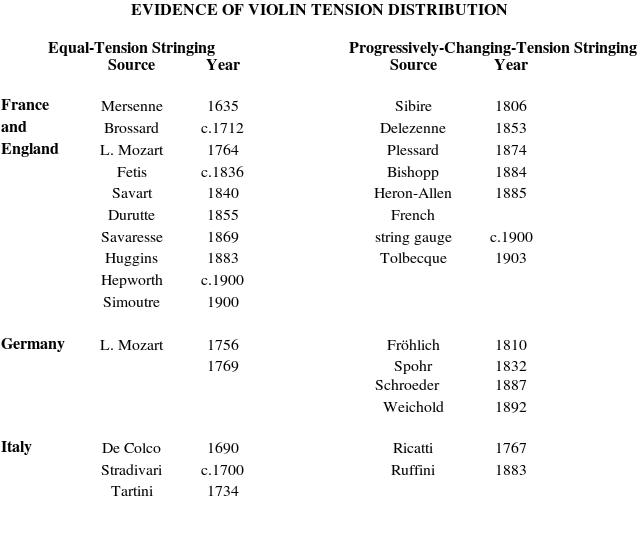
Northern Renaissance Instruments
6 Needham Avenue, Chorlton-cum-Hardy, Manchester M21 8AA, U.K.
Phone & Fax. +44 (0) 161 881 8134 ; proprietor: Dr. Ephraim Segerman [USA]
e-mail: post@nrinst.co.uk ; on internet: http://www.nrinst.co.uk
HISTORICAL VIOLIN, VIOLA AND CELLO STRINGS UP TO 1900
Most of the information in this leaflet is taken from The Strad 99 (1988), No 1173 pp. 52-55 (Jan), No 1175 pp. 195-201 (Mar) and No 1176 pp. 295-299 (Apr), where there is further detail, information and explanation. Additional information is from 'Roman and Neopolitan Gut Strings' by Patrizio Barbieri in the Galpin Soc. J. LVIV (2006), pp. 147-182. The intention here is to offer guidance for players who would like to explore how the original stringings in the baroque, classical and Romantic period felt and sounded like, and how this might influence their interpretations of music from these periods.
VIOLIN STRINGINGS

In the above Table we list the sources providing information concerning whether the four violin strings were at the same tension (equal-tension stringing) or, as is universal today, the 4th string was at the lowest tension, the 3rd had greater tension, the 2nd had greater tension yet, and the 1st had the highest tension of all (progressively-changing-tension stringing). If the tension of each string deviated from the average of the set by no more than 10%, the stringing is listed as 'equal tension'.
From this Table we conclude that before the middle of the 18th century, equal-tension stringing was usual throughout Europe. Subsequently, progressively-changing-tension stringing was introduced in Italy in association with the introduction of a wound 4th string, and soon became the usual type of stringing from then on in that country. This type of stringing spread to the rest of Europe by the end of the 18th century, probably associated with Italian opera. Nevertheless, many violinists in England and (especially) France still used equal-tension stringing throughout the 19th century.
In the next Table, we list the evidence on the types of construction of violin 3rd and 4th strings used
up to 1900. The first two strings were always of gut. None of the evidence distinguishes between low-twist and high-twist gut. Low-twist gut lasts much longer for the 1st string, but at the a'=c.380 Hz usual Italian pitch standard, a high-twist 1st could last long enough for some. Except for the Talbot ms, none of the evidence for the 3rd or 4th string distinguishes between high-twist and catline gut. A catline's rope construction is much more necessary for a 4th than a 3rd string.
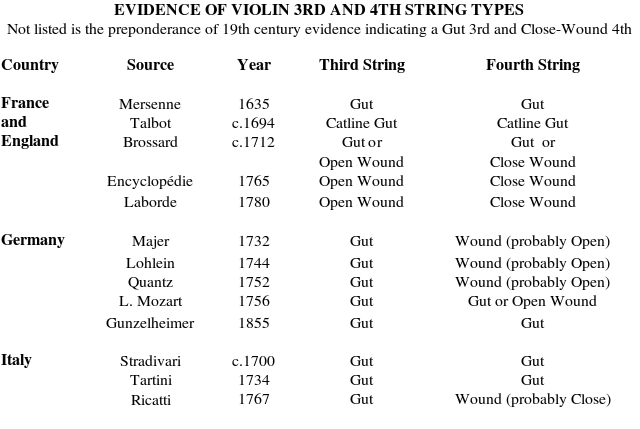
The first evidence for the availability of wound strings is from around 1660, and the only evidence of their extensive use before the end of the 17th century is for the lowest string of some bass instruments (viols and violins), usually to perform the functions of larger ones. As seen from the Table, the French started using an open-wound 3rd and close-wound 4th early in the 18th century, and this became their standard stringing through most of the rest of the century. Early in that century, the Italians preferred gut 3rds and 4ths, while the Germans, balancing influence by the Italians and the French, adopted a compromise stringing with only a wound 4th. That this was open wound (always with the option that it was just gut) is deduced from Leopold Mozart, who indicated the the 4th was the thickest string. Since the late-18th century Italian progressively-changing-tension stringing spread to dominate Europe in the 19th century, and 19th century stringing involved a close-wound 4th, it is likely that the close-wound 4th was associated with this type of stringing from its beginning (Ricatti).
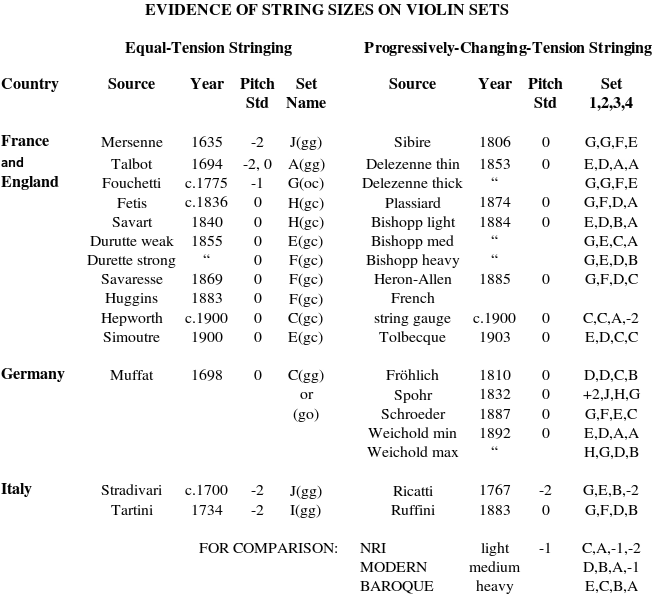
Listed in the preceding Table is the heaviness of the violin strings in the sets we have historical evidence for. In those sets with equal-tension stringing, the Set Name gives the letter of the relevant row in the Ranges and Prices table plus, in parentheses, the type of the third string followed by the type of the 4th string (with 'g' unwound, 'o' open-wound or 'tigerline' and 'c' close-wound). In those sets with progressively-changing-tension stringing, the rows in the Ranges and Prices table are given for the first-to-fourth strings in that order. The string types for these 19th century sets are all with an unwound gut 3rd and a close-wound 4th. It is expected that the first two strings in all sets were low-twist gut, and when both the 3rd and 4th were unwound gut, they were (following Talbot) both catlines. It is also expected that from the final third of the 18th century onwards, in sets which had an unwound gut 3rd and a close-wound 4th, the 3rd was of high-twist gut.
When the violin replaced the treble viola da braccio in the fiddle dance band, it had to play loudly. This leads us to expect that the very heavy stringing in Mersenne's evidence (J sets) was universal for dance bands in his time. In England and Germany, where violins often played chamber music with viols, lower tensions would be expected. It is probable that in Protestant Germany then, where the pitch standard was a tone higher, the strings were two semitone steps lighter (H sets) to have the same dance-band tension and projection.
Later in the 17th century, the viol was the favourite of the French aristocracy, who insisted on playing with the violins, so violins had to adopt very low tension for balance. This stringing was exported to England in the Restoration, from where we have the Talbot evidence (A sets). In England then, the violin played at close to modern pitch in fiddle bands, but tuned down a tone to play with viols. Evidence from Prin (about marine trumpet and bass violin strings) implies that by 1742, French (and probably English) violin tension was up again, to that indicated by Fouchetti (G sets).
Muffat stated that German stringing was a little stronger than French, and it is likely that these were C sets. The Italians appear to have continued the early use of heavy stringing (J sets) to at least the middle of the 18th century. A piece of evidence from 1743 indicates that Tartini had recently increased his string-tension level, possibly up to the previous level which had been dropping. Fröhlich's early 19th century tension level was low, suggesting that Muffat's low tensions might have survived throughout the 17th century.
There is no evidence about how progressively-changing-tension stringing progressed in Europe in the final third of the 18th century after its adoption in Italy. It was probably adopted in Germany before France. Early 19th century evidence from Sibire in France and Fröhlich in Germany show compromises between this stringing and equal-tension stringing. There is considerable evidence that violin string tensions went particularly high in the second quarter of the 19th century. This is reflected in Spohr's stringing (as heavy as the instrument could bear), and more mildly in Fetis's and Savart's stringings. The lower tensions after that are marked by similar but quite diverse stringings. Bishopp's 'light' stringing shows the beginning of a c.1900 movement in England and France for very light stringing, which developed into the Hepworth and French-string-gauge sets. That movement did not last, but the pressure for lower tension continued, presumably for less effort in playing and quicker response. Modern violin stringing has tensions very similar to Bishopp's 'light' stringing.
We are often asked for a set of strings historically appropriate for playing Bach or Mozart. We can be quite sure that the stringing approximated equal tension. Leopold Mozart not only indicated that one could hang weights on the strings to be sure that the tensions were equal, but also mentioned that the fourth string was thicker than the third and the third thicker than the second. This rules out a close-wound string next to an all-gut higher string because it would be thinner. The only possibilities then are no wound strings (like the Italians), a half-wound 4th (implied by Majer's 1732 statement that only the 4th was wound), or a half-wound 3rd and a close-wound 4th (like the French). It is likely that Leopold Mozart didn't discuss wound strings on the violin (as he mentioned wound strings on the viola d'amore) because it was a matter of controversy.
Germans had traditionally adopted whatever they liked from French and Italian influences. Around 1700, much appeared in print about the very contrasting sounds made by Italian and French string bands. Much of this was due to the difference in string tensions, with the French using light strings near the top full row in the Table of Strings, and the Italians using heavy strings near the bottom row. Muffat wrote that the Germans used strings 'a little stronger' than the French, and if we take this to mean 'somewhat thicker', this can be estimated to be about row 'C'.
By the middle of the 18th century, there is evidence that French tensions went up towards Italian levels, but it is likely that many if not most of the Germans did not follow, since the tensions given by Fröhlich in 1810 differs little fron those of Muffat in 1698, both in tension level and tension distribution (equal or nearly equal). The Fröhlich information is appropriate for the music of Beethoven, and probably Mozart. If we go back to Bach's time, it was similar, but the combination of an unwound 3rd and a close-wound 4th is highly unlikely.
The following table lists the diameters or EDs (equivalent diameters in solid gut for the same weight) and prices of all of the violin strings within the historically-indicated ranges, given at semitone-step intervals of heaviness. It is arranged so that the lettered rows are equal-tension sets. The rows marked -2, -1, +1 and +2 are needed to cover the diameters (or EDs) of strings used in progressively-changing-tension sets and not used in the equal-tension sets. Equal-tension sets will be identified by the row letters, while the progressively-changing-tension sets will be identified by the row for each string, showing well how the tension varies. The first string in each of the equal-tension sets is one semitone-step heavier than theoretical equal tension with the rest of the set would be, but it ends up close to the same tension as the others when it gets thinner from stretching. The prices are for first quality strings, unpolished catlines and silver-plated-copper windings. Polishing of catline violin strings cost £4.90. We would be glad to quote for alternatives.
RANGES OF VIOLIN STRING DIAMETERS (OR EDs) AND PRICES
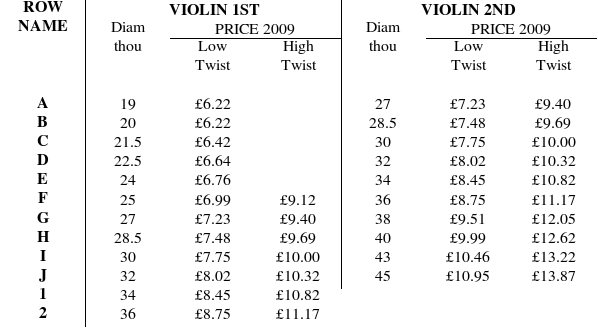
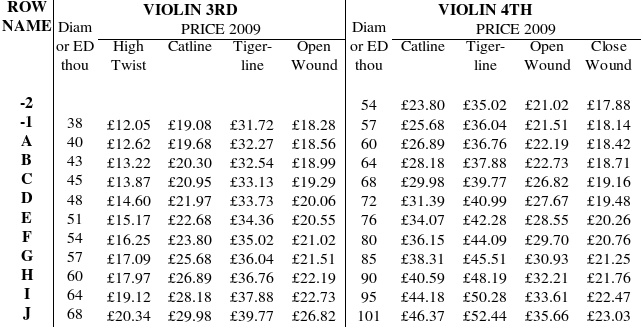
HISTORICAL VIOLA, CELLO AND BASS VIOLIN SETS
Historical evidence of the stringing of violas before the 20th century is very scarce. That for cellos is a bit better. Nevertheless, there are two approaches that help to generate historically credible viola and cello sets from an historical violin set. One is the traditional practices of using strings for the violin on these other instruments. The other is that there is good historical reason to expect that the string tensions on the violin viola and cello are proportional to the vibrating string lengths.
There is considerable evidence that violas used the lower three strings of violins as their higher three strings. This specifies the diameters, string types and tension profiles of these strings, leaving the 4th to be determined. From known stringings, if the tensions of the first three are equal, the viola 4th tension would be the same. If the tensions are progressively changing, the tension of the 4th would be lower than that of the 3rd by no more (and usually less) than the amount that the 3rd is less than the 2nd. In 18th century France, it was usual for the violin 3rd to be half-wound (either open-wound or a tigerline) and the 4th close wound. This accounts for the viola 2nd and 3rd, and then the 4th would be close-wound as well. Before the 18th century everywhere, and till halfway in that century in Italy, it was usual for violin 4ths and viola 4ths to be all gut. If the violin 4th was half-wound (as was common in earlier 18th century Germany), we would expect the viola 3rd to be the same, and then the fourth string would be close-wound.
Since cellos first appeared in Italy around 1700, the paintings show that they have always had two wound strings, probably both close-wound. In France, cellos did not compete successfully with the basse de violon until the second half of the 18th century. Their 1st strings were usually the same as violin 3rds in the 19th century, and probably in the 18th century as well.
When we generate a viola or cello set from the violin information, the row letters in the Ranges and Prices tables in this brochure are related to those in the violin brochure by the tension-length principle, an empirical generalisation that is consistent with historical evidence and works practically. According to that principle, the tension on the viola or cello row with the same row name is the violin tension multiplied by the ratio of string lengths.
Cellos and Bass Violins
Cellos as we know them were not invented until the end of the 17th century. Before then the basses of the fiddles (as opposed to violones) in string bands were either Italian bass violins (usually tuned an octave below the violin) with about 62 cm string stops, or French bass violins (tuned a tone lower than the cello) with about 80 cm string stops. Around 1600, Italian amateurs often played 5-string bass violins with about 73 cm string stops tuned like the the normal bass violin (an octave below the violin) plus a low C. From around 1660, when metal-wound strings were invented, we first hear (in Bologna) of the instrument name 'violoncello', meaning a small instrument that could effectively play normal violone parts. It was most probably an Italian bass violin fitted with a metal-wound fourth, tuned a fifth lower, like our cello. Only well into the 18th century, when the newly-invented larger size eventually replaced the original bass violin, did the name mean only our cello. The French bass violin was used for much more of the 18th century in France than the Italian one elsewhere.
Both types of bass violin were most probably always tuned with equal tension. On the Ranges and Prices table of cello strings, a set of strings for the French bass violin that matches a particular violin set would be the same as the matching cello set. A set for the Italian bass violin would be six rows higher than the matching cello set (essentially the same strings as the viola). There is evidence from 1742 (Prin) suggesting that the stringing of the French bass violin then was all-gut in about the 'G' row.
There was a fashion outside of Italy of particularly high tensions in the 1830s and 1840s. When the tensions came down again in the 1850s, some cello stringings (see the Lapaix 1853 evidence) kept the high tension of the cello 4th. This situation was temporary, and the cello 4th subsequently returned to be either the same or slightly lower tension than the 3rd.
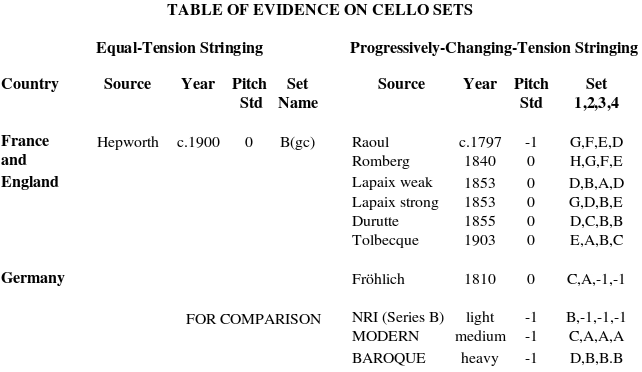
Catlines and Prices
Except for French stringing at the time of Lully (late in the 17th century), early stringing was heavier than modern stringing. The heavier a string is, the slower is its response. A smooth polished catline is more popular nowadays than an unpolished catline. For a polished catline, add £9.80 to each cello catline price and £5.95 to each viola catline price listed in the Ranges and Prices tables.
RANGES OF VIOLA STRING DIAMETERS (OR EDs) AND PRICES
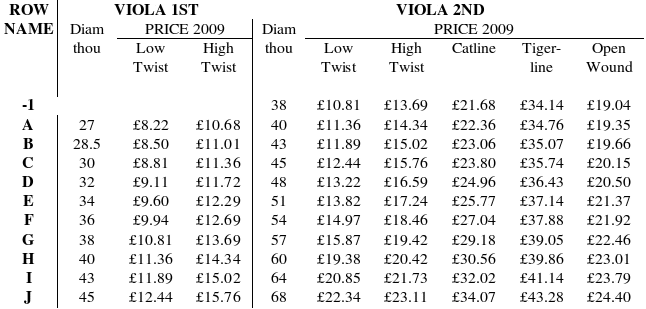
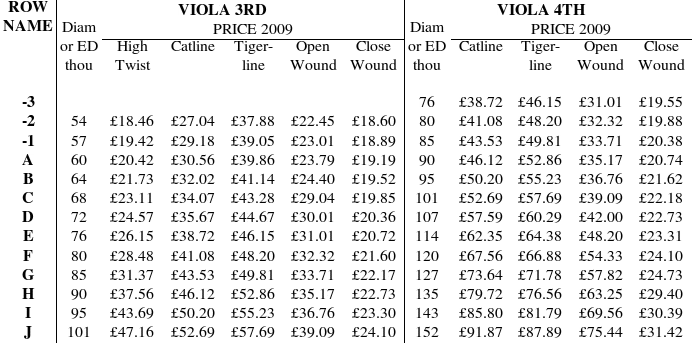
Metric Equivalents

RANGES OF VIOLONCELLO STRING DIAMETERS (OR EDs) AND PRICES

